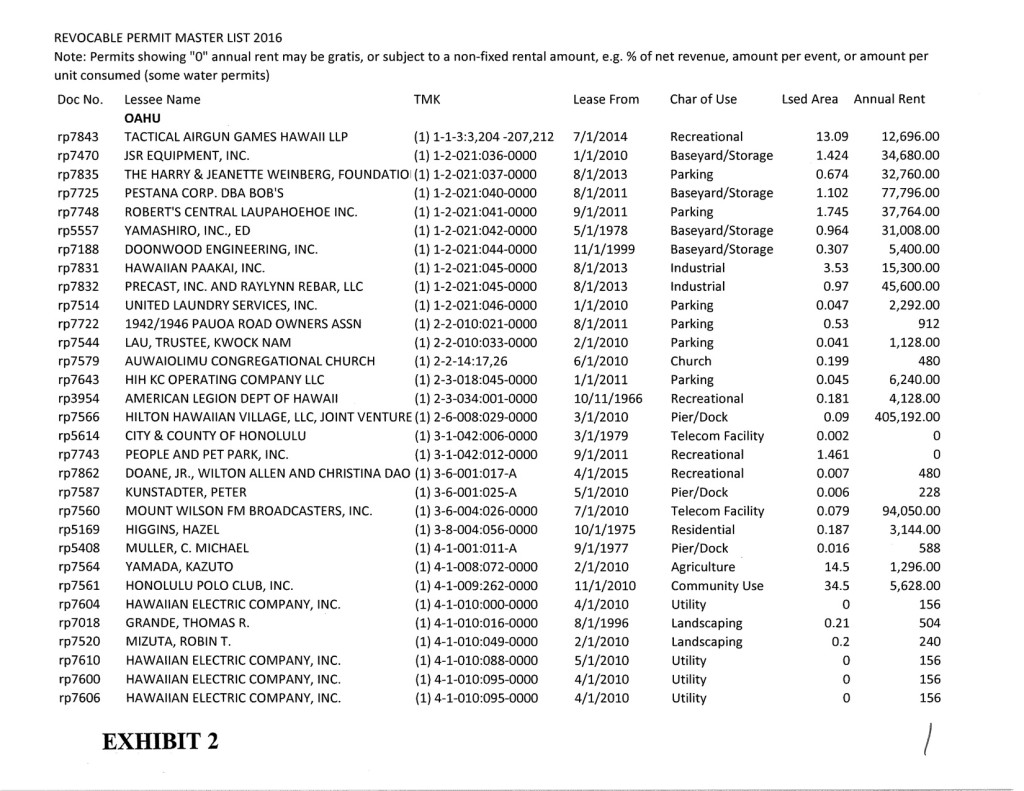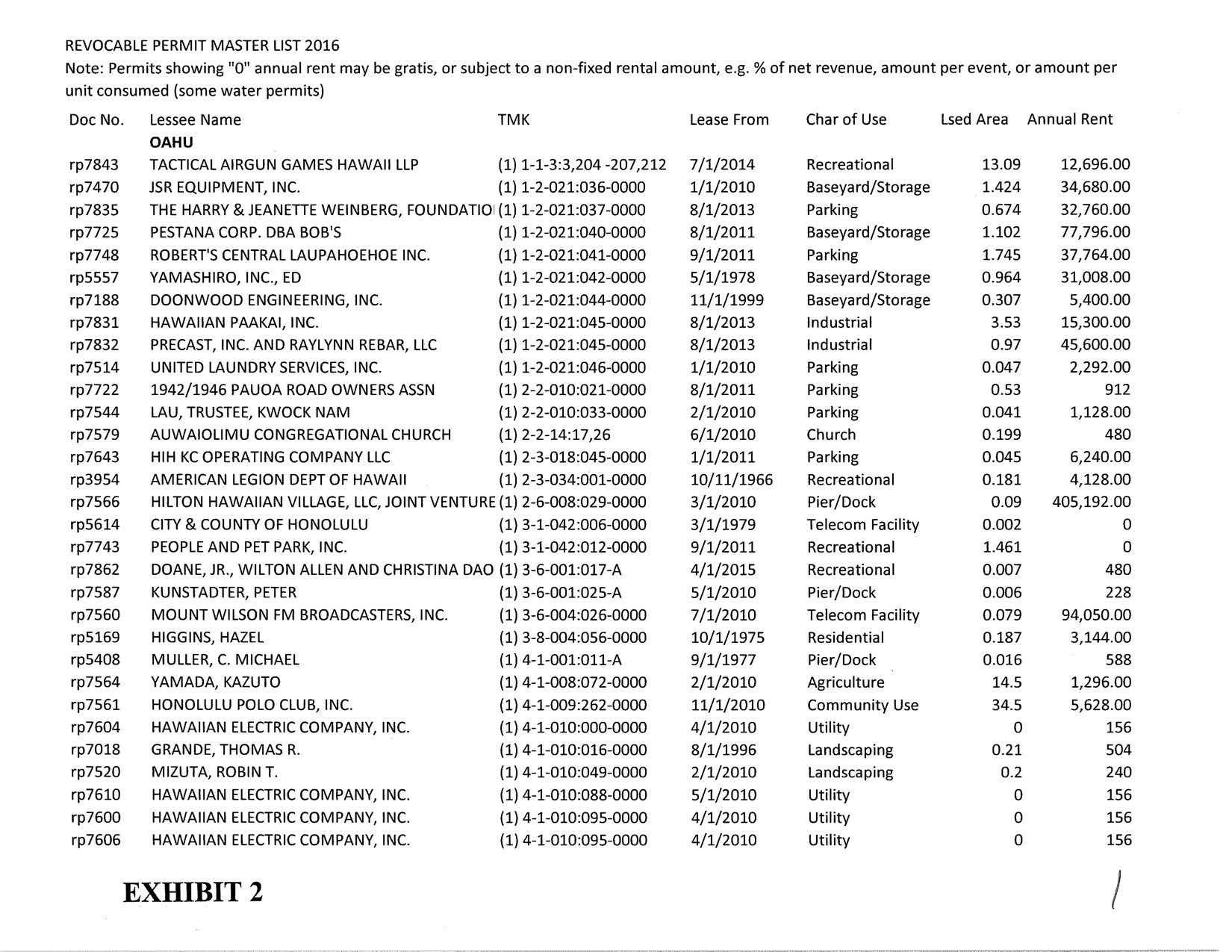 For years, every December, the Department of Land and Natural Resources’ Land Division has submitted a list of hundreds of revocable permits (RPs) to the Board of Land and Natural Resources for renewal, for everything from a 40-square-foot empty lot the division wants an adjacent landowner to maintain, to, as our cover story notes, the use of 33,000 acres of state land to divert hundreds of millions of gallons of water a day from East Maui.
For years, every December, the Department of Land and Natural Resources’ Land Division has submitted a list of hundreds of revocable permits (RPs) to the Board of Land and Natural Resources for renewal, for everything from a 40-square-foot empty lot the division wants an adjacent landowner to maintain, to, as our cover story notes, the use of 33,000 acres of state land to divert hundreds of millions of gallons of water a day from East Maui.
This year, members of the public and the Land Board took the division to task for not providing even basic information about each of the permits to be renewed. The list it provided contained the name of each permittee, the tax map key number for the property, the date the permit was first issued, the character of use (i.e., parking, church, recreational, agriculture), the land area, and the annual rent.
Native Hawaiian Legal Corporation attorney David Kimo Frankel, who testified only on the four permits to Alexander & Baldwin and East Maui Irrigation Company, ridiculed the Land Division’s “Exemption Notification” that the annual permit renewal was exempt from environmental review because there were no changes in use.
“What is really profoundly disturbing is the one-page exemption determination that your staff provided to you,” he told the Land Board. “This is really an embarrassment. We’re talking about the diversion of hundreds of streams and the conclusion that it doesn’t have a significant impact …”
He added that contrary to what’s required by the department’s administrative rules, the division had not consulted with anyone on the renewals.
“If Land Management walked across the hall to DAR [the Division of Aquatic Resources], they might have seen the 2009 study on the significant impact of stream diversions. … To claim that the diversions are not having a significant impact is belied by the sister division of DLNR’s own study,” he said.
With regard to the list of permits as a whole, Marti Townsend, director of the Sierra Club, Hawai`i Chapter, testified that the board needs much more information than what it was given to decide whether or not to renew.
“You need to know the exact location, the current conditions … This kind of cursory review is not okay,” she told the Land Board at its December 11 meeting.
She added that the board needed to assess the permits’ impact on traditional and customary practices, evaluate any changes to the property and surrounding uses, and determine whether others may want to use the property.
Conservation Council for Hawai`i director Marjorie Ziegler took a particular interest in how the rents were being calculated. She noted that in the case of the four to A&B and EMI, the recommended rent amounted to between $5 and $9 per acre per year. Other permits for smaller areas had really high rent, she said.
“It would be nice if you and the public could get a little more information on how the rents are determined. Aren’t you worried someone is going to sue you that their rent is higher? … Also, the department needs the money,” she said.
She urged the Land Division to look more closely at each permit and ask itself whether it was proper to remain a revocable permit.
“It’s just like a bad habit. You keep approving these lists of permits without any deliberation here,” she said.
A number of the Land Board members agreed that the Land Division (and the Division of State Parks, which had submitted a similar list earlier in the meeting) needed to provide more information to the board.
“I think the general gist of this is we want … more transparency in what’s going on with this piece of land or this permit,” board chair Suzanne Case told the Land Division’s Kevin Moore.
The Land Board ultimately approved the list as submitted (except for the four permits to A&B and EMI), but directed the division to include in next year’s submission an explanation of why each permit area is not being put out for lease and of the basis for the rent amount if it is not set at market rates.
The board also asked that the division bring the renewal requests to the board in four separate meetings next time, one for each island group, and to return to the board in June with an update on three of the permits.
Board member Chris Yuen wanted to revisit the permit for the Country Club condo on Hilo’s Banyan Drive to make sure the board wasn’t giving the tenant too much of a rent break. He also wanted to evaluate whether McCandless Ranch should continue to use a parcel known as the Waiea tract on Hawai`i island.
“It is an environmentally sensitive area … with the `alala (endangered Hawaiian crow) and other issues. I’d like to see a concurrence by DOFAW [the DLNR’s Division of Forestry and Wildlife] on the continuation and the use of this as an RP. When I was on the board 20 years ago, I said this should be limited to access rather than pasture,” he said.
Board member Stanley Roehrig also wanted the division to report back on a permit to Kukio Resorts for 2,500 acres of pasture land for $216 a year.
“That’s a gated community and they lock the gate unless you’re a landowner or a vendor,” he said, adding, “These are the guys with the jets at the airports. … The Land Board’s not supposed to take care of the really rich guys at the expense of the poor guys.”
With the changes asked for to next year’s round of permit renewals, Yuen said he expected the board to have “a little bit of a better sense we’re doing the right thing.”
— Teresa Dawson


Leave a Reply